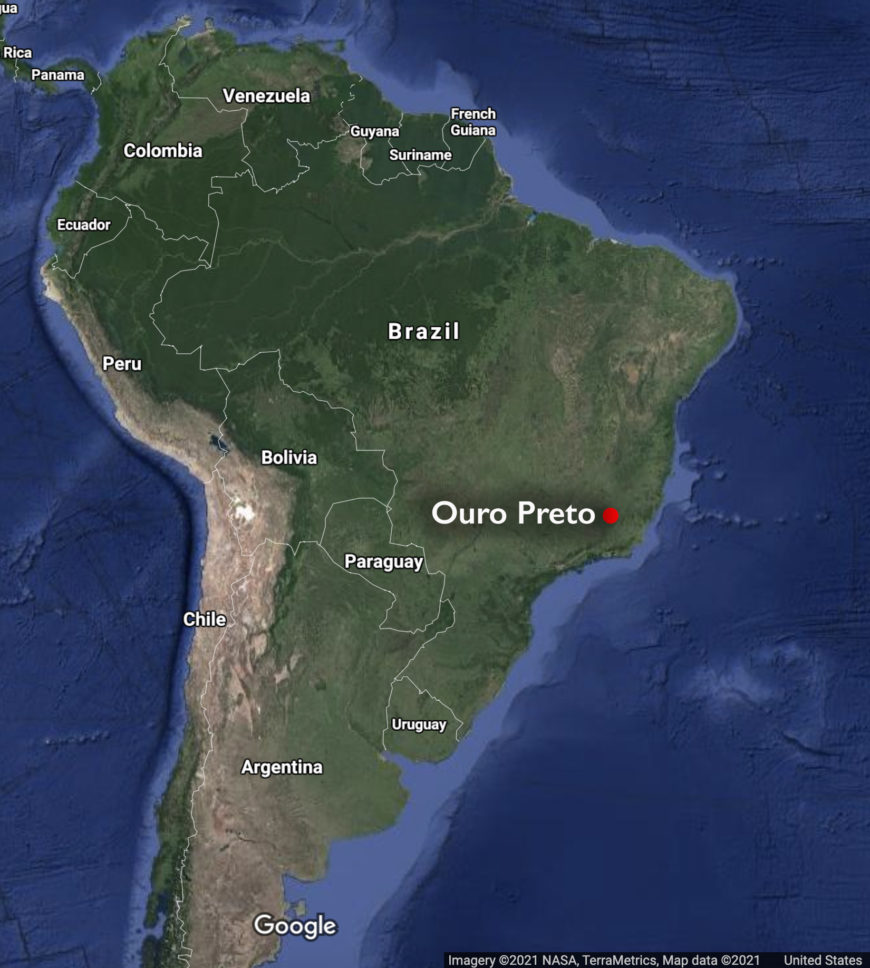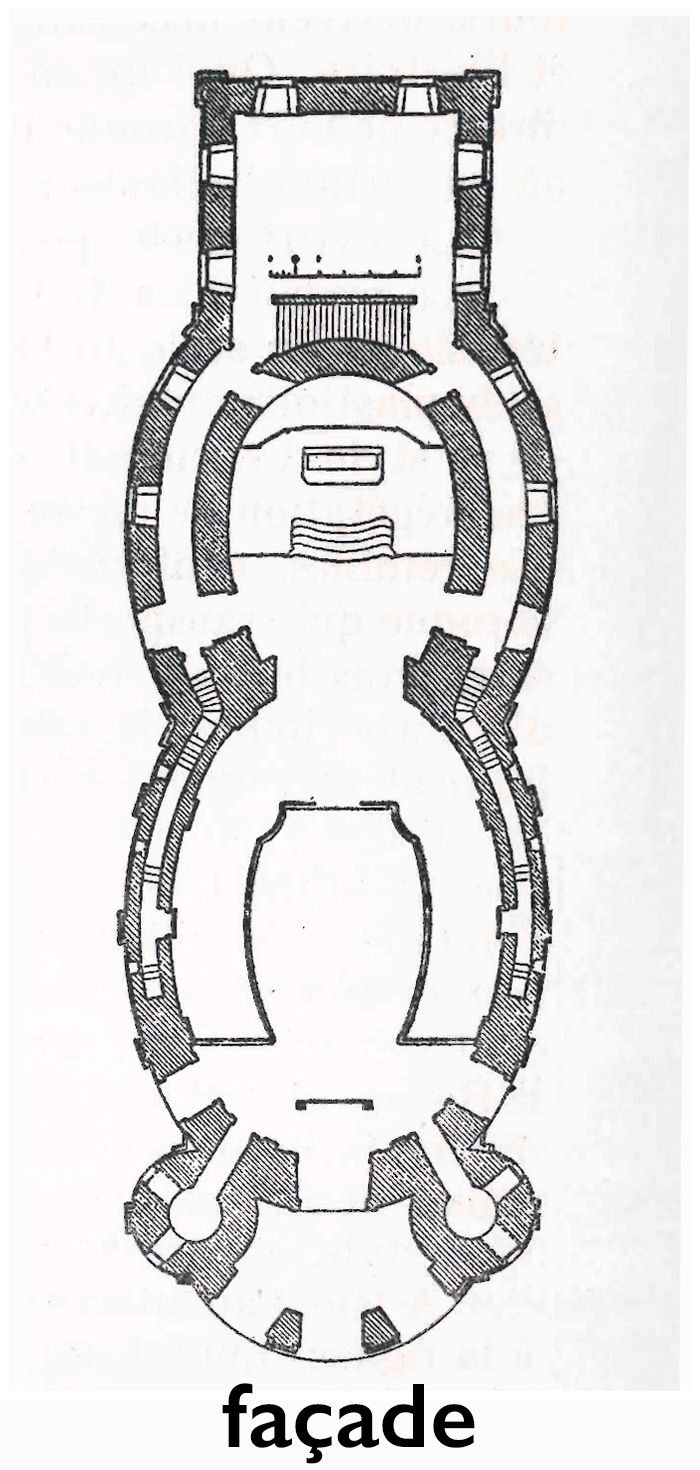
Church of Our Lady of the Rosary of the Blacks, 18th century, Ouro Preto, Brazil (photo: Juliana Bruder, CC BY-SA 4.0)
Afro-Brazilian brotherhoods
In eighteenth-century Brazil, people of African descent founded and joined Catholic brotherhoods (lay associations dedicated to Marian and saintly devotions, and charitable work). In a world that provided no safety net for Afrodescendants, brotherhoods allowed Afro-Brazilians to pool resources to care for each other, especially when members fell ill or died. Black brotherhoods included free-born, freed (or manumitted), and enslaved members who paid a small fee to join and to stay active. These fees and other financial activities (such as loan programs and real estate investments) allowed Afro-Brazilian brotherhoods to care for members. The discovery of gold in Brazil during the 1690s also brought wealth to Afro-Brazilian brotherhoods, as members mined for a share of the profit or had their own mines (like the legendary Chico Rey—a mine owner who is said to have financed the construction of his brotherhood’s church, St. Iphigenia).
While Catholic brotherhoods were found all over the Spanish and Portuguese empires, only in Brazil did brotherhoods for people of African descent manage to build their own churches. Some of these churches are among colonial Brazil’s most beautiful and include work by the best architects and painters of the period, many of whom were black, such as Aleijadinho or Mestre Valentim. Studying these churches allows us to see how people of African descent expressed themselves through religion, art, and architecture.
Although designed by a white architect, the Church of Our Lady of the Rosary of the Blacks in Ouro Preto is among the most famous of these Black brotherhood churches. In fifteenth-century Portugal, the Dominican Order founded Rosary brotherhoods (brotherhoods dedicated to praying the Rosary and Our Lady of the Rosary) for Blacks as a means of integrating newly arrived Africans into Catholicism. As a result, most Afro-Brazilian brotherhoods were Rosary brotherhoods and many of their churches are dedicated to Our Lady of the Rosary (a Marian advocation that originates with a 12th-century vision of Saint Dominic receiving a rosary from the Virgin Mary to fight heretics).
Our Lady of the Rosary of the Blacks today
An unusual design
The brotherhood of Our Lady of the Rosary of the Blacks obtained their first chapel in 1716, later replacing the small chapel with the present church in 1764. The brotherhood used the church as their place of worship and, as with many black brotherhood churches in Brazil, continue to do so today.
José Pereira dos Santos designed the current plan of two connected ovals shortly before his death in 1764. Only two churches from the period, both designed by Pereira, have this shape: the Rosary of the Blacks and St. Peter in Mariana. This uncommon shape allowed the church to stand out from the customary rectangular structures, thereby indicating the elevated socioeconomic status of its members.
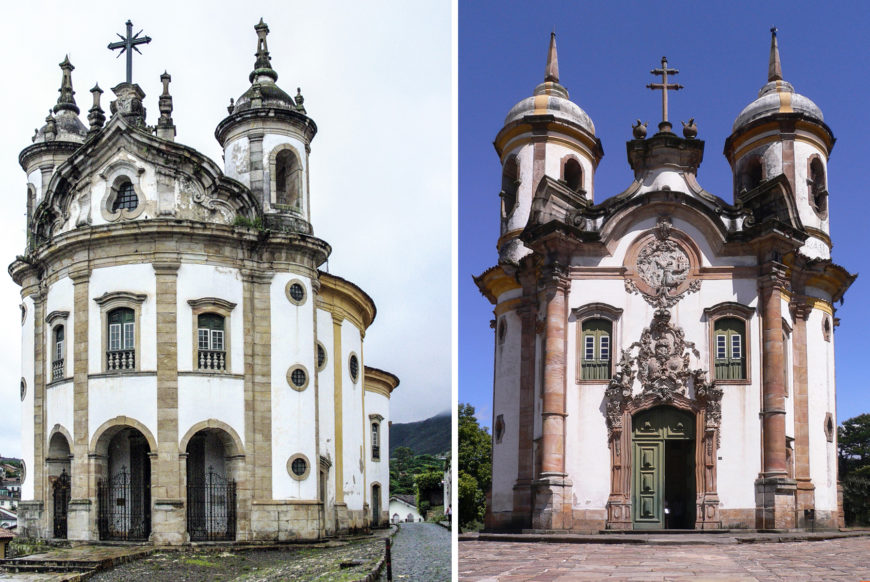
Left: Church of Our Lady of the Rosary of the Blacks, 18th century, Ouro Preto, Brazil (photo: Juliana Bruder, CC BY-SA 4.0); right: Church of São Francisco de Assis, Ouro Preto, Brazil (photo: svenwerk, CC BY-NC-ND 2.0)
In 1785, the brotherhood commissioned local architect Manuel Francisco de Araújo to update the façade according to prevailing tastes in Brazil. Araújo revised the church’s exterior and added the bell towers. The church’s façade, like its interior, is in the iconic Mineiro Rococo style. This style was common in this region and is characterized by its whitewashed walls and elaborate stone moldings, its towers resembling those of the nearby Church of Saint Francis (designed and executed by Aleijadinho).
The present church was completed in 1793, and its interior was finished by Manuel Ribeiro Rosa and José Gervásio de Sousa. This region was home to Black, white, and mixed-race artists but records do not mention a racial designation for Manuel Ribeiro Rosa and José Gervásio de Sousa. In addition to these named artists, extensive building projects such as this one depended on a large workforce that may have included members of the brotherhood.
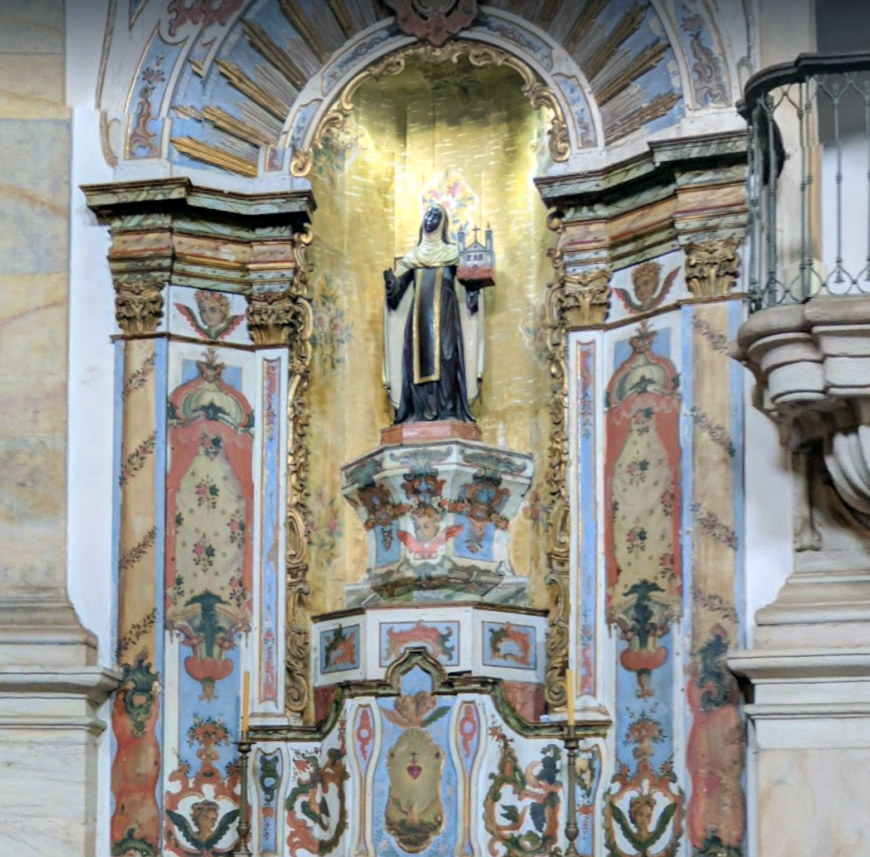
Saint Iphigenia, inside the Church of Our Lady of the Rosary, Ouro Preto, Brazil (photo: Giuliano Orlando)
Expressing agency with Black saints
Black brotherhoods made churches their own through devotion to black saints, like the legendary St. Iphigenia (a 1st-century Ethiopian princess), St. Kaleb of Axum (a 6th-century Ethiopian king), and Benedict the Moor and Anthony of Carthage—the latter two lived in Renaissance Italy, first as slaves then as freed, religious men.

Saints Benedict and Anthony, inside the Church of Our Lady of the Rosary, Ouro Preto, Brazil (photo: Ricardo André Frantz, CC BY 3.0)
The Church of Our Lady of the Rosary of the Blacks contains six side altars with niches ornamented with painted and carved rocaille (elaborate ornamentation with pebbles and shells) frames. Inside the niches are statues of the black saints Iphigenia, Kaleb, Benedict, and Anthony. The last two niches (across from one another, and nearest the church’s entrance) are dedicated to white saints, namely the Virgin and Child and St. Helena of Constantinople. The rounded walls with these side altars direct the gaze forward toward a painted wooden arch framing the main altar, and calling attention to the statue of Our Lady of the Rosary at its center.
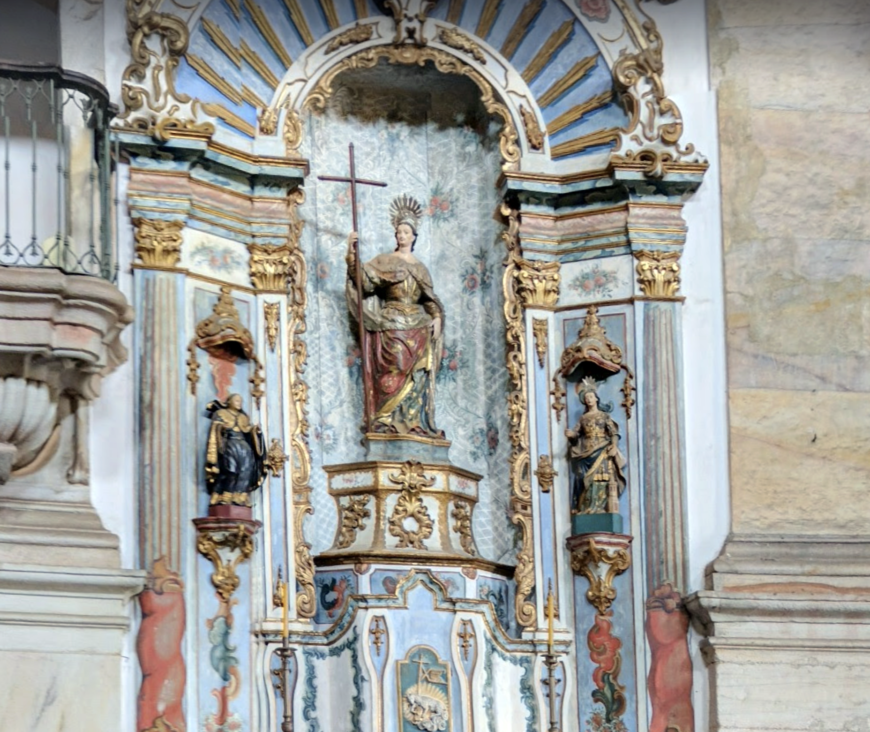
Saint Helena, inside the Church of Our Lady of the Rosary, Ouro Preto, Brazil (photo: Giuliano Orlando)
St. Helena and the importance of conversion
The inclusion of St. Helena, the mother of the Roman Emperor Constantine, among these black saints may initially seem surprising. According to the early Christian father Eusebius of Caesarea, Helena converted to Christianity soon after Constantine became Emperor of Rome in 306 C.E. She convinced her son to convert to Christianity and made it the official religion of the Empire. Later in life, she traveled to Palestine to recover the cross on which Jesus had been crucified, which she brought back to Rome with her. She is shown holding the cross in the sculpture. Her presence in the church speaks to the brotherhood’s devotion to the Cross and commitment to spreading Christianity following her example, but through the Rosary rather than the cross.

Painting of Saint Benedict receiving a rosary from an angel at the entrance to the Church of Our Lady of the Rosary of the Blacks, 18th century, Ouro Preto, Brazil (photo: Ricardo André Frantz, CC BY 3.0)
St. Benedict
A ceiling painting of St. Benedict at the entrance of the church includes another reference to St. Helena. The painting shows the black saint receiving a Rosary from an angel. The angel offering Benedict the rosary tells him In hoc signo vinces (“by this sign you will conquer”), the same phrase that appeared to Constantine in Greek before the Battle of the Milvian Bridge. Here, the brotherhood members put their stamp on Christian iconography in two ways:
First, by creating a new narrative of St. Benedict receiving a Rosary on behalf of the black race. Normally St. Dominic of Guzman, the founder of the Dominican Order, is depicted receiving the Rosary from the Virgin Mary, which he then teaches to others. Here a black saint receives it directly from an angel, creating an uninterrupted link between his race and heaven. This is significant because blackness had been seen as evil from the Middle Ages and only whitened through conversion. Here a black saint is given a new instrument of conversion and salvation.
Second, the brotherhood members reshape an existing Christian narrative by replacing the Cross with the Rosary as the symbol of salvation. Thus, the painting declares that the brotherhood members will win admission to heaven through praying the Rosary. In other words, by constantly praying the Rosary, Mary will intercede so God can reward them with eternal life in paradise.
Another message of the painting is that the brotherhood members are charged with converting and catechizing new African arrivals through the Rosary, because the Rosary is a meditation on the principal tenets (beliefs) of Catholicism. Ouro Preto was a new town (originating in the late 17th century) where the black population was predominantly recently enslaved Africans. The membership of the brotherhood was not necessarily made up of African-born members, but the brotherhood made Christianizing newly arrived Africans part of their mission. While colonial Afro-Latin Americans have been generally viewed as the target of conversion efforts by white missionaries, this painting shows Afrodescendants doing lay missionary work themselves.
Afro-Brazilian agency
Ouro Preto’s Church of Our Lady of the Rosary of the Blacks speaks to the kind of artistic and socioeconomic agency Afro-Brazilians, whether enslaved, free, or freed, wielded in the eighteenth century. It shows the ways in which Afro-Brazilian brotherhoods manipulated Catholic imagery to give their temples an Afro-centric iconography that expressed their group, Catholic, and racial identity. Beyond that, the Church invites us to think about the ways early modern Afrodescendants expressed themselves through art and other objects.
Additional resources:
Miguel A. Valerio, “Architects of Their Own Humanity: Race, Devotion, and Artistic Agency in Afro-Brazilian Confraternal Churches in Eighteenth-Century Salvador and Ouro Preto.” Colonial Latin American Review, forthcoming 2021
Virtual tour of the city of Ouro Preto that includes the church of São Francisco de Assis
Gauvin Alexander Bailey, The Spiritual Rococo: Decor and Divinity from the Salons of Paris to the Missions of Patagonia (London: Taylor and Francis, 2017)

